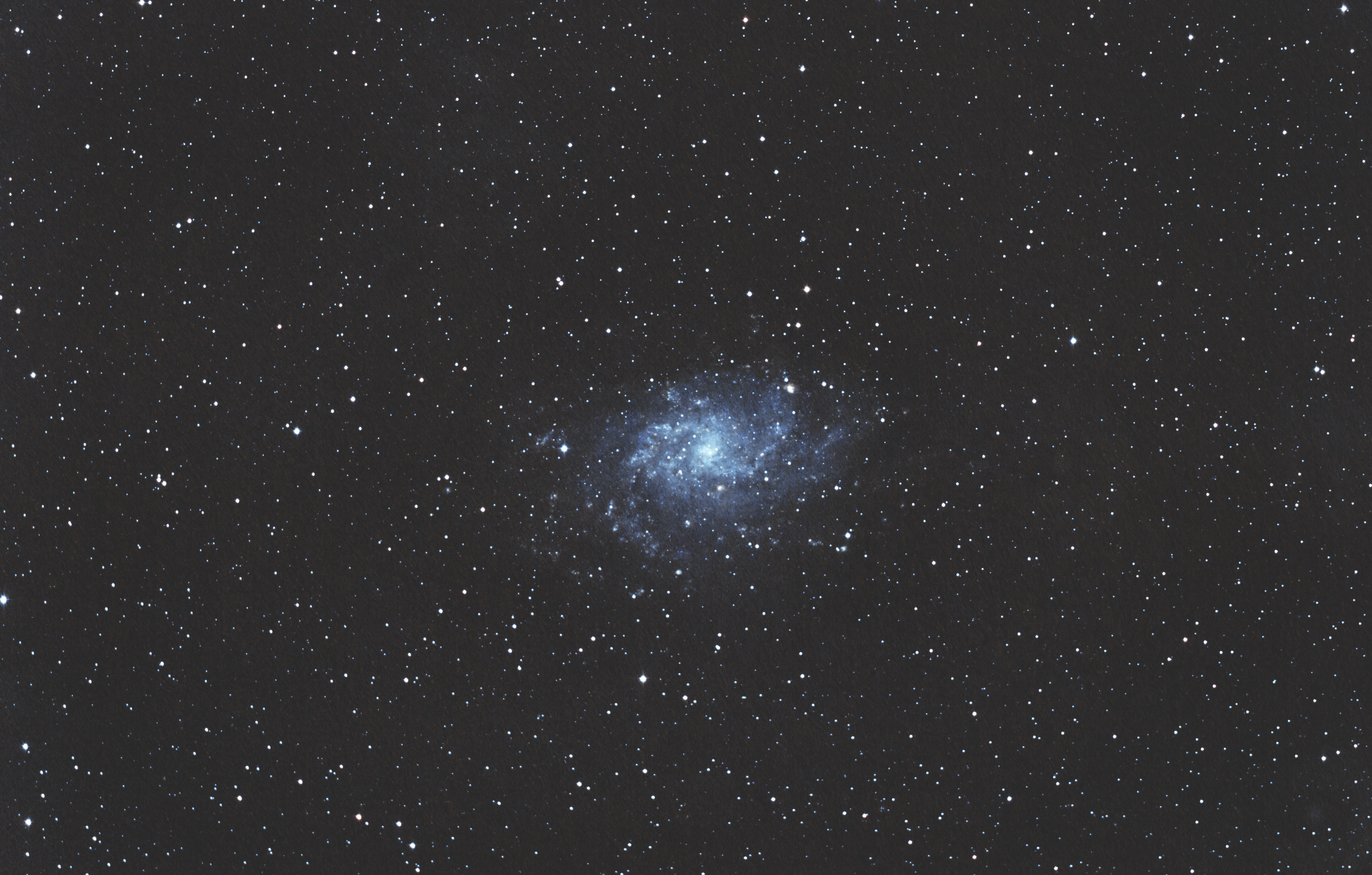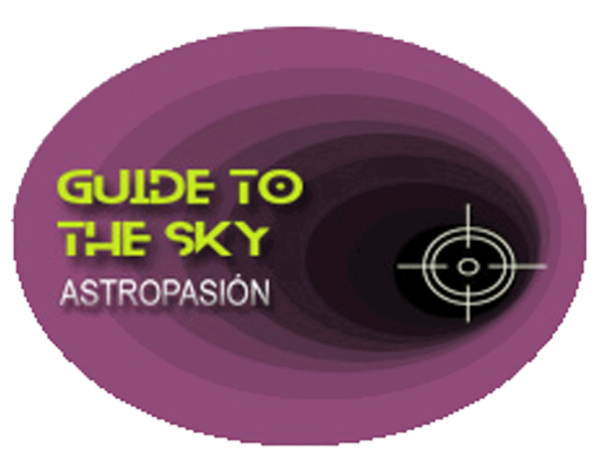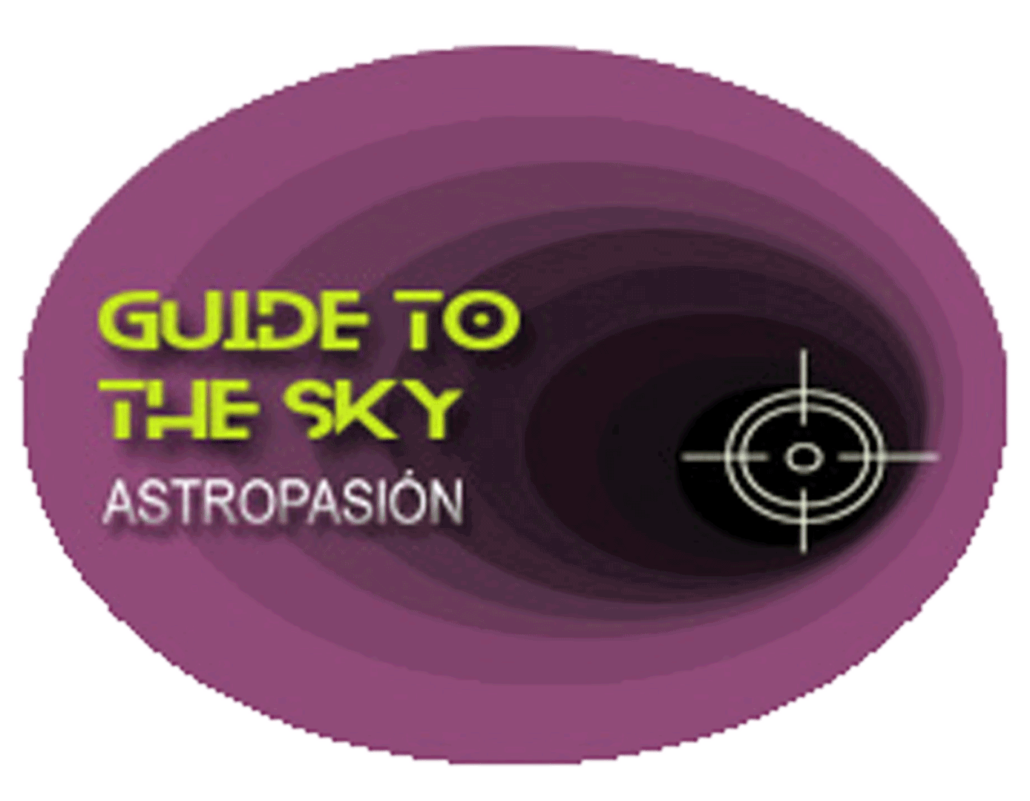Messier 33 - Triangulum

A pesar de su magnitud conjunta 5.7, M33 es un objeto débil en cuanto a luminosidad por unidad de superficie ya que M33 es grande: una regíón elítipca de ejes {{object[0].M33.angularN }} y {{object[0].M33.angularM }} minutos de arco.
M33 no está lejos visualmente de M31, a unos 13º al SE de ésta última aunque, en realidad M33 está algo más lejos de nosotros, dista {{object[0].M33.mesDistances[0].dist }} {{ object[0].M33.mesDistances[0].unit }}, es decir entre 300 y 600 Millones de años luz más que M31.
En M33 predominan los colores azulados y rosáceos de sus alas debido sus numerosas regiones de formación estelar HII, por lo que un filtro UHC o similar funcionará muy bien para su observación o astrofotografía. Por cierto que una de estas regiones HII es NGC 604, una de las más amplias que se conocen. Incluso en el mismo centro de M33 es muy probable que podamos fotografiar una nebulosa oscura que lo cruza, queriendo formar una especie de puente. También es llamartiva una alineación de 4 estrellas de la 12ª Magnitud, las cuales pertenecen ya a nuestra galaxia.
Son numerosos los varios satélites tiene M33 y que podemos obtener en una astrofotografía, por citar algunos: NGC 598, NGC 603, NGC 588.
M33 - Galaxia del Triángulo - en la IA
Messier 33 (M33), also known as the Triangulum Galaxy, is a spiral galaxy located in the constellation Triangulum. Here's a comprehensive overview:
Key Facts and Information:
- Type: Spiral galaxy (Sc, meaning it's a relatively loosely wound spiral)
- Distance: Approximately 3.07 million light-years from Earth.
- Size: About 60,000 light-years in diameter (smaller than the Milky Way).
- Mass: Estimated to be between 50 and 60 billion solar masses.
- Apparent Magnitude: 5.7 (visible to the naked eye under very dark skies).
- Constellation: Triangulum
- Designation: Messier 33, M33, NGC 598
- Discovery: Discovered by Giovanni Battista Hodierna before 1654. Independently rediscovered by Charles Messier on August 25, 1764, and cataloged as M33.
Characteristics and Features:
- Structure: A relatively face-on spiral galaxy, allowing for detailed observation of its structure. Its arms are less tightly wound than those of many other spiral galaxies.
- Star Formation: M33 is actively forming stars, particularly in its spiral arms. It's known for its high number of HII regions (regions of ionized hydrogen gas), which appear as bright pinkish-red areas in images.
- Giant HII Region: NGC 604: One of the largest and brightest HII regions known, located within M33. It's a region of intense star formation, containing hundreds of young, massive stars.
- Local Group: M33 is a member of the Local Group of galaxies, which also includes the Milky Way, the Andromeda Galaxy (M31), and many smaller dwarf galaxies.
- Gravitational Interaction: M33 is gravitationally interacting with the Andromeda Galaxy (M31). Astronomers believe it's either orbiting Andromeda or on a trajectory for a future collision. The exact nature of the interaction is still being studied.
- Metallicity: M33 has a lower metallicity (abundance of elements heavier than hydrogen and helium) than the Milky Way and Andromeda. This is typical of galaxies in the outer regions of the Local Group.
Observing M33:
- Visibility: Under exceptionally dark, moonless skies, M33 can be glimpsed with the naked eye as a faint, diffuse patch of light. However, it's more easily observed with binoculars or a telescope.
- Binoculars: Even small binoculars will reveal M33 as a hazy oval.
- Telescopes: Larger telescopes will reveal more detail in the spiral arms and allow you to observe prominent features like NGC 604.
- Location: M33 is located in the constellation Triangulum, which is best observed in the autumn and winter months in the Northern Hemisphere. Look for the relatively faint constellation Triangulum southeast of the more prominent constellation Andromeda.
Significance:
- Study of Spiral Galaxies: M33 is a valuable object for studying the structure, star formation, and dynamics of spiral galaxies. Its relatively close proximity and face-on orientation make it an ideal target for detailed observations.
- Local Group Dynamics: Understanding M33's relationship with the Milky Way and Andromeda helps astronomers model the evolution of the Local Group.
- Distance Ladder: M33 has been used to refine the cosmic distance ladder, a series of techniques used to measure distances to increasingly distant objects in the universe. Cepheid variable stars within M33 have played a key role in this process.
In Summary:
Messier 33 (the Triangulum Galaxy) is a fascinating spiral galaxy located in our cosmic neighborhood. Its active star formation, relatively clear view of its structure, and interaction with the Andromeda Galaxy make it a popular object of study for astronomers and a rewarding target for amateur observers.
Más información sobre Messier 33 en NASA/IPAC.
Mapa alrededor de Messier 33
Otros identificadores de M33:
"1AXG J013351+3039" ,"2E 409" ,"2E 0131.0+3024" ,"HIJASS J0133+30" ,"LEDA 5818" ,"M 33" ,"MCG+05-04-069" ,"NAME Triangulum Galaxy" ,"NAME Triangulum Pinwheel" ,"NGC 598" ,"RBS 214" ,"RX J013351+30399" ,"TC 906" ,"UGC 1117" ,"Z 0131.0+3024" ,"Z 502-110" ,"2MASX J01335090+3039357" ,"1ES 0131+30.3" ,"1RXS J013350.9+303932" ,"[CHM2007] LDC 160 J013350.90+3039357","[M98c] 013101.7+302415" ,"UZC J013351.1+303922" ,

